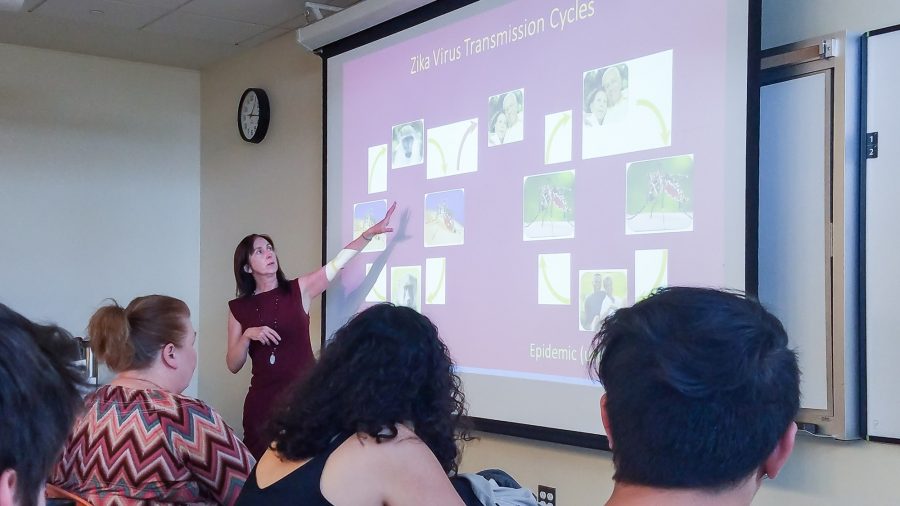During Multicultural Day, guest speaker Barbara Spraktes, a faculty member of California State University Northridge, educated students about the dangers of the Zika virus and argued that people should take it seriously.
The Zika Virus seems to have only caught attention recently with the first cases in the U.S. being discovered in Florida, but the virus has been around since the late 1940s.
The Zika virus was discovered by isolating the virus from a rhesus monkey in the Zika forest of Uganda in 1947. There are currently 5,158 confirmed cases of the Zika virus in the continental U.S., 4,861 of which were travel-related, according to the European Center for Disease Prevention and Control.
The transmission of Zika can be from a maternal-fetal connection, sexual contact with someone with the virus, blood transfusion, and organ/tissue transplant. To protect yourself from the virus, Spraktes suggests you avoid traveling to areas where Zika is prevalent.
“People should take the Zika virus seriously, they shouldn’t be careless about where they travel,” said Spraktes. “They’d be better off changing travel plans or going somewhere else to avoid it.”
Spraktes stated how only 20 percent of those infected become symptomatic. Symptoms include: acute fever, rash, and conjunctivitis. While fatalities from the Zika virus are very rare, it’s the effect Zika has on fetuses that is most concerning.
The Center for Disease Control (CDC) reported that one in every ten babies whose mothers carried the Zika virus suffered severe birth defects. Zika can cause a myriad of problems for pregnancies including miscarriage, fetal growth abnormalities, brain abnormalities from microcephaly causing seizures, neurobehavioral abnormalities, hypertonia which is an abnormal increase in muscle tension, and defects in the eyes.
Data from the CDC suggests that later gestational age at infection does not exclude potential adverse impact.
Attendee Brennan Wright, a 23-year-old biology major described what attracted him to attending this event.
“It’s an extra credit assignment for one of my classes,” said Wright. “So I picked one that sounded interesting to me.”
In February 2016, the World Health Organization declared Zika a public health emergency, currently 64 countries are at risk of Zika, including Mexico, Central Africa, 28 countries in the Caribbean, southeastern Asia, seven Central American countries, 11 South American countries, and three U.S. territories.
In May 2015, the first known Zika infection in Brazil was found. By October of that year, the virus began to infect more and more. As of June 2016, there are 224 confirmed cases and 3,017 suspected to be infected, according to the World Health Organization.
“Do anything to avoid it,” said Spraktes. “it’s not worth it to have a baby that will have those kinds of problems.”








Rose Writes • Apr 25, 2017 at 3 -07:00.04.
The most likely co-factor is Wolbachia.
RE: Wolbachia-infected Mosquito Releases: FDA Seeking Public Comments
Wolbachia can never be taken back. Wolbachia is responsible for the most widespread pandemics in the animal kingdom (LePage and Bordenstein, 2013).
Safety tests were never carried out on vertebrate species prior to Wolbachia-infected mosquito releases (carried out in Brazil, Columbia, India, Indonesia, Vietnam, China, Australia, California, and Florida). It’s akin to putting genetic dynamite in a species.
Wolbachia can survive about a week in a dead host. Lateral transfers to other species have happened. Thiscould be the reason that Zika is spreading out of control. Culex that naturally acquire Wolbachia are better vectors of malaria and West Nile virus (very similar to Zika).
And YES, some species of Culex larvae will prey upon Aedes aegypti larvae. There are multiple ways this can happen.
Wolbachia doesn’t just magically disappear when these mosquitoes die off naturally or are consumed.
“Wolbachia spp. should be further evaluated as causes of human infection, especially as Wolbachia infection of mosquitoes is increasingly considered to be a tool for interfering with mosquito-borne transmission of human pathogens” (Chen, Dong, et al., 2015). NOTE: Filariodea coxI gene was not found in this case. Source: http://www.clinicalmicrobiologyandinfection.com/article/S1198-743X(14)00040-8/fulltext
Source: More Proof Wolbachia Infected Mosquito Releases Might Be Causing the Most Devastating Zika Infections
“These genetic tools might not be the best strategies for ZIKV given that at this point there seem to be multiple vectors not only at the species but also at the population level. The current genetic technologies would not be appropriately applied to such complex systems.” Source: https://f1000research.com/articles/5-2546/v2
I have submitted my comment to the FDA about the dangers of Wolbachia-infected mosquito releases. Here is a video recording (transcript shown at end): https://www.youtube.com/watch?v=kY_IymvoIG8&t